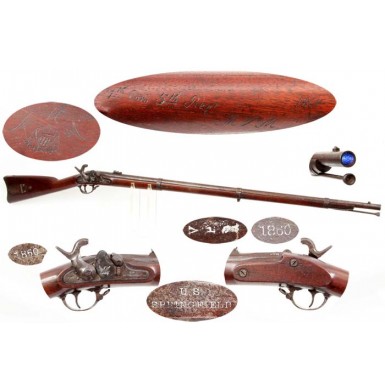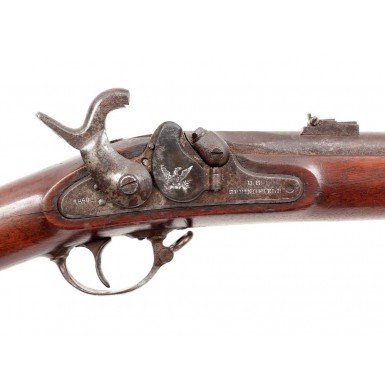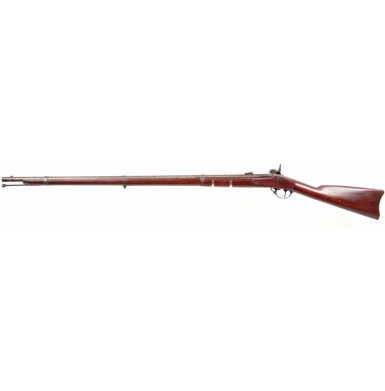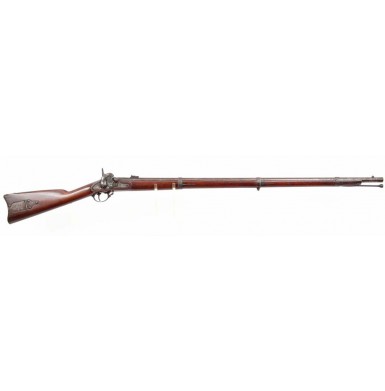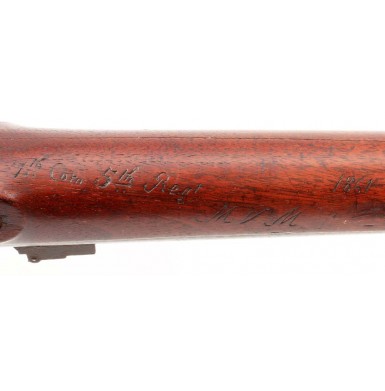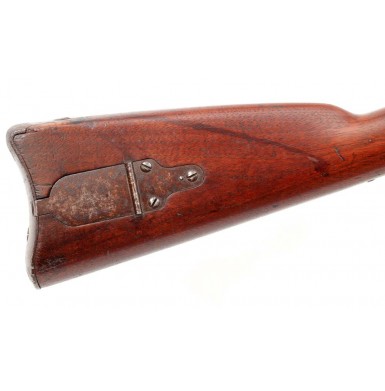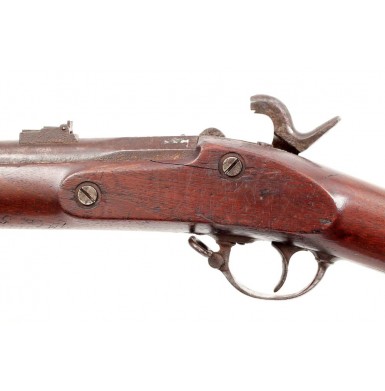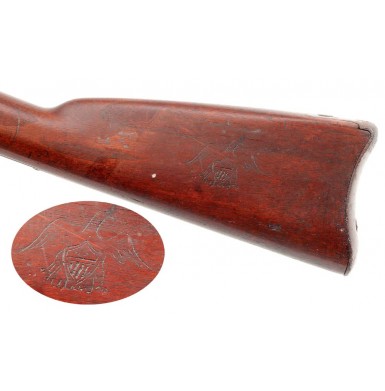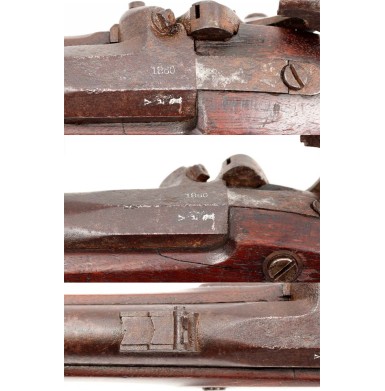1st Manassas Unit ID'd US M-1855 Rifle Musket
- Product Code: FLA-3078-SOLD
- Availability: Out Of Stock
-
$1.00
This is a wonderful, untouched example of the US M-1855 Rifle Musket in VERY GOOD+ to NEAR FINE ATTIC condition. The gun also has a lovely period carved identification linking it to the 5th Massachusetts Volunteer Militia (5th Massachusetts Volunteer Infantry), and as a result the Battle of First Manassas (Bull Run). This example was produced at the famous US arsenal at Springfield, MA. The adoption of the Model 1855 by the US Ordnance Department was significant for a number of reasons. It was the first reduced-caliber infantry long arm to be adopted for universal issue, being only .58 caliber, while all previous issue infantry muskets were .69 caliber. It was also the first rifled arm intended for widespread issue to all arms of the military. Prior to the M-1855, smooth bore muskets were the standard infantry arm, and rifled arms were reserved for specialty troops and were not issued in significant numbers. It was also the first US military arm specifically designed for use with the Burton Ball (the American modified version of the expanding base French Mini” ball). Finally, the M-1855 incorporated the automatic tape priming mechanism of Dr. Edward Maynard. This mechanical priming system used a varnished paper roll of priming pellets, much like a modern roll of caps used in a child’s cap gun. The system advanced the roll every time the hammer was cocked, placing a fresh primer pellet over the cone (nipple). A sharp cutting edge on the bottom face of the hammer cut off the spent piece of priming tape when the hammer fell. The M-1855 was officially adopted in 1855, but production did not get under way at the Springfield Armory until 1857, and at Harpers Ferry until 1858. Springfield produced a total of 47,115 M-1855 rifle muskets from 1857 to 1861 and Harper’s Ferry produced another 23,139 between 1858 and 1861. Although most collectors do not know this, the US Ordnance Department did let some contracts for the production of the M-1855 rifle muskets. These contracts went to A.M. Burt, J.D. Mowry, J.F. Hodge, J. Mulholland and A. Jenks & Son. However, the complicated tape priming mechanism slowed tooling and pre-production work, and none of these contractors ever delivered a single M-1855 rifle musket. However, all of them did deliver the simplified M-1861 rifle musket (which eliminated the tape primer system) after the Civil War erupted in 1861. The only contractor known to have completed any M-1855 rifle muskets with a functional Maynard tape primer was Eli Whitney Jr., but these were never part of any official US Ordnance Department contract and it is believed that the 350 arms of this pattern that he built (using condemned US armory produced locks) were all sold to the state of Connecticut. The M-1855 went through a couple cosmetic and functional changes during its production run at the National Armories. Initially it was produced with a long base, long-leaf adjustable rear sight, similar to the ones found on rifled & sighted US M-1842 muskets and some alterations of the Harpers Ferry produced M-1841 rifles. The M-1855 was also originally produced with a brass forend cap. In 1858 a new pattern rear sight was adopted. This sight featured a short base with an L-shaped leaf for 100 and 300 yard shooting and a longer 500-yard leaf. While Springfield started installing the new pattern of 1858 back sights in that year, Harpers Ferry did not start the installation of the new sight until 1859. In 1859 the nose cap was changed from brass to malleable iron and an iron patch box was authorized for installation in the obverse of the buttstock. As with any change in specifications for assembly line produced items, the changes went into effect as stores of older parts were used up. This results in a variety of rear sight and stock forend combinations, as well as a number of older stocks being used on 1859 dated specimens that do not have the patch box cut out. The US M-1855 Rifle Musket was produced with a 40” round barrel that rifled with three broad grooves. The front sight served as a stud for an angular socket bayonet. The stock was of walnut, and the overall length of the musket was 56”, and it weighed in at 9 pounds, 3 ounces without the bayonet. The US M-1855 Rifle Musket saw significant use during the American Civil War. It was the most advanced US made rifle musket in production when the hostilities broke out. The M-1855 initially saw service with most of the US Regular Infantry regiments as well as a few US volunteer and militia regiments, and eventually saw issue along side US M-1861 rifle muskets to a much larger number of regular and volunteer infantry regiments. Although the gun incorporated the Maynard priming system, the majority of Civil War issued M-1855s were fired with traditional percussion caps. This was due to issues with the fragility and reliability of the primer tapes.
The US M-1855 Rifle Musket offered here is a VERY GOOD+ to NEAR FINE ATTIC condition example that was produced at the Springfield Armory in 1860. During fiscal year 1860, the Springfield Armory produced only 8,600 M-1855 rifle muskets. The gun features the July 28, 1858 pattern, short base rear sight and the post-April 21, 1859 iron forend cap. The same April 21, 1859 changes included the addition of an iron patchbox, to be inlet in the obverse buttstock. Due to the need to adapt machinery for the inletting of the patchbox and the need to fabricate the patch box covers, the patch boxes were not incorporated into production at Springfield until July 9, 1859. As this gun is dated “1860”, it incorporates the iron patchbox in the stock. The gun is clearly and crisply marked on the lock: U.S. / SPRINGFIELD in two horizontal lines forward of the hammer and 1860 in a horizontal line to the rear of the hammer. The matching 1860 date is clearly visible on the breech of the barrel, but is somewhat weaker due to oxidation and flash pitting from use. The tape primer door is clearly stamped with the correct, Springfield pattern spread-winged eagle. The typical V P (EAGLE HEAD) proof and inspection marks are present on the angled left breech flat. The butt plate tang is stamped with the typical US mark. The three inspector initials SRC are stamped into the wood behind the triggerguard in the belly of the stock. There are no visible cartouches on the flat opposite the lock, which is odd, as the stock shows no indications of being sanded or vigorously cleaned, so there is no clear reason why they should not be present. The most intriguing marks on the stock are both period added carvings. The reverse buttstock is neatly carved with a folk-art spread-winged Federal Eagle with a shield in its breast. Additionally, the belly of the stock is carved between the lock and the rear most barrel band:
7th Com 5th Regt MVM 1861
This marking identifies the musket to the 7th Company of the 5th Massachusetts Volunteer Militia (5th Mass. Vol. Infantry). According to research by George Moller, the state of Massachusetts received 800 US M-1855 Rifle Muskets in 1860 and an additional 1,100 during 1861, which means that as many as 1,900 M-1855s could have been in Massachusetts state stores with the production date 1860 when the first state regiments of volunteers were raised to “suppress the rebellion” of the southern states. The 5th Massachusetts Infantry was an early war, 90-day regiment organized in April of 1861 immediately after the firing on Fort Sumter, which was mustered into service in Washington D.C. on May 1, 1861. The regiment was initially encamped in Alexandria, VA, serving in the defenses of Washington. It was subsequently attached to Franklin's Brigade, Heintzelman's Division, of McDowell's Army of Northeast Virginia. The regiment participated in the advance on Manassas, Va. from July 16-21, 1861. The regiment fought at the 1st Battle of Bull Run (1st Manassas) on July 21, 1861. After the retreat from Manassas, the regiment was ordered to Boston on July 29, and was mustered out there on August 1, 1861. Another 5th Massachusetts Volunteer Infantry Regiment was formed in August of 1862 and served for 9 months, through June of 1863, mustering out in July of that year, after about 11 months of service. It is clear from the inscription that this gun was carried by a member of the 7th company (likely company “G”) of the 5th Massachusetts Volunteer Infantry during their service in 1861, including the battle of 1st Manassas.
The gun is 100% complete and correct in every way and has absolutely no repairs or replacement parts. The only exceptions are that the percussion cone (nipple) is broken off at the cone seat, and the upper sling swivel is also broken off. The complicated and delicate Maynard lock system is mechanically excellent and works crisply and correctly, exactly as it should. The gun retains the correct original Pattern 1858 rear sight, complete with correct swept-wing style sight leaves. The original lower sling swivel is in place on the triggerguard bow, while the swivel on the middle barrel band is broken. The original front sight & bayonet lug is in place at the end of the barrel. The original swelled-shank, tulip-head ramrod is in place in the ramrod channel and retains good threads on its end. The metal of the gun is mostly smooth throughout, with some scattered areas of minor to moderate surface oxidation and some crusty surface roughness scattered over the metal surfaces. The breech area of the gun shows even, light to moderate flash pitting from the percussion ignition system.The balance of the barrel, forward of the rear sight shows scattered oxidized peppering and pinpricking. This is most noticeable near the muzzle of the musket, but in no way detracts from the overall appearance of this wonderful M-1855. The buttplate shows very thick surface oxidation and some moderate surface roughness. The metal has a mostly uniform, thick brown, “attic” patina that is untouched and uncleaned. When the barrel bands are moved, the metal of the barrel under them remains much of its original arsenal bright polish. The metal of the gun remains fairly crisp, with good edges and lines throughout. As would be expected of any rifle musket that saw significant field service over 150 years ago, the metal shows some scattered bumps, dings and minor impact marks. The screw hole in the tang of the breech plug is cracked and appears to be broken through the hole, the result of the screw being over tightened at some point in time. The bore of the rifle rates about GOOD and retains visible, 3-groove rifling in its lower recesses, but the rifling near the muzzle appears to be completely worn or shot out. The bore shows moderate to heavy pitting, evenly distributed along its entire length, and has a very dark, dirty brown, heavily seasoned appearance commensurate with the exterior condition of the gun and the clear evidence of significant use. The stock rates about VERY GOOD+ condition and is very crisp for a gun that saw a lot of use in the field. It is full length with no breaks or repairs present. The stock does, however, show a couple of grain drying cracks. The longest runs from the front of the triggerguard to the rear most barrel band along the belly of the stock. This is tight and stable and is not structural. There is also a short, tight grain crack to the rear of the lock mortise, and one running from the rear most lock screw to the barrel channel. None of these drying cracks significantly detract from the untouched appearance of the musket. The stock retains very extremely crisp with very sharp edges and lines and the wood to metal fit is very fine. The stock shows no indications of any sanding, or even cleaning. The stock does show a significant number of scattered bumps, dings, scratches and even some gouges from carry, service and use. There are, however, absolutely no indications of abuse and no repairs are noted.
Overall this is a really nice, untouched and “fresh from the attic” example of one of the most attractive and innovative patterns of US rifle musket ever produced. The lines and visual appeal of the M-1855 have always been very attractive to me, and the unique tape priming mechanism gives these guns much more character than the cookie-cutter, workman-like appearance of the later M-1861 rifle muskets. The gun is 100% complete and correct in every way (with the two small exceptions noted above) and is in a really nice state of preservation. The wonderful period folk art eagle carved on the stock and the great period inscription identifying the gun to the 5th Massachusetts in 1861 make this a really special gun. This rifle musket was present at the very beginning of the American Civil War, on the battlefield at Fist Manassas, the very first significant battle of the American Civil War. The M-1855 was the standard issue rifle musket for the US infantry at the beginning of the American Civil War and the majority of the guns saw hard service during the war, especially with the pre-war regular army regiments. All of those factors, along with their relatively limited production numbers, make unmolested M-1855s difficult to find for sale. This one has the coveted patchbox, and is the most desirable variant of the M-1855 produced. Between late 1859 and the end of production 1861, less than 20,000 of the 47,115 M-1855s produced at Springfield incorporated the iron patchbox. Every Civil War long arm collection needs a M-1855 rifle musket in it, and this very really nice, untouched example from Springfield Armory that would be a great addition to your collection, and that you will be very proud to own. The fact that it was present for the fight at First Manassas makes it an even more historical and extremely important weapon that deserves a place in the most advanced collection of Civil War military long arms.

